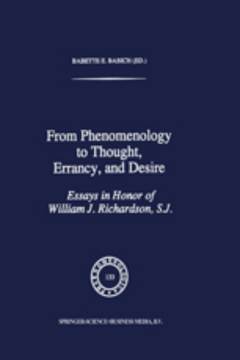Repository | Book | Chapter

(1995) From phenomenology to thought, errancy, and desire, Dordrecht, Springer.
"Lacan." We will be a long time assimilating the far-ranging theoretical innovations in psychoanalysis that are associated with his name. Exploiting the richness of Freud's text in ways little anticipated even by Freud's closest adherents, Lacan reconceives the most basic psychoanalytic concepts, including those of the unconscious itself and the process of repression. The effect of these innovations is to recalibrate the analytic microscope along the lines of Lacan's three cardinal categories of imaginary, symbolic, and real. On the one hand, Lacan defines the Freudian ego as a precipitate of the imaginary. During the "mirror phase," the psychically formative period between the ages of six months and two years, the contours of the infantile ego are laid down in identification with the perceptual unity of the body image. In this way, Lacan rediscovers the profound appropriateness of the term "narcissism" and opens up a whole series of new problematics around the function of perception and the meaning of the object relation in psychoanalysis. On the other hand, Lacan draws upon the structuralist conception of language as a diacritical system to provide a new understanding of the nature and destiny of unconscious desire, that of "the unconscious structured like a language." Lacan thus stakes out a provocative claim, yet one that becomes increasingly plausible when we reread Freud with an eye to the way in which the workings of the unconscious are revealed over and again to turn around plays on words and phonemic linkages. As a grand system of differences, the structure of language comprises an immense and precisely articulated web, intractable to perceptual representation, in which the desire of the subject unknown to the ego finds its circuit toward expression. The first two registers of imaginary and symbolic are triangulated by a third, that of the real, by which Lacan points enigmatically toward an unencompassable horizon that remains unthinkable and unknowable. The real forever outstrips everything figured by the imaginary or signified by the symbolic. As much an expression of the ineffable ground of the subject's own being as that of the world beyond it, the real escapes all representation, even as its indeterminate force may be encountered in the experience of the uncanny or evidenced in the effects of the trauma.
Publication details
DOI: 10.1007/978-94-017-1624-6_26
Full citation:
Boothby, R. (1995)., "Now you see it …": the dynamics of presence and absence in psychoanalysis, in B. Babich (ed.), From phenomenology to thought, errancy, and desire, Dordrecht, Springer, pp. 397-430.
This document is unfortunately not available for download at the moment.



